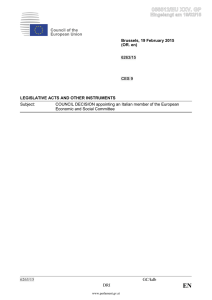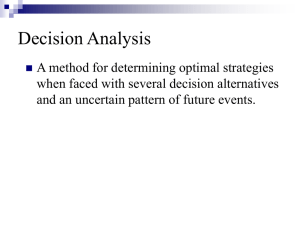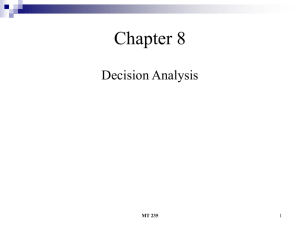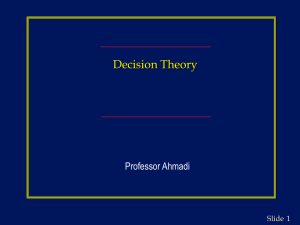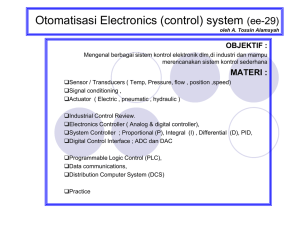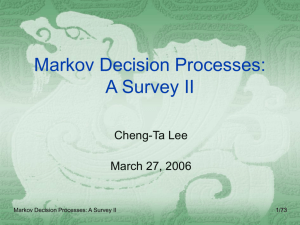Chapter 9 Signal Detection
advertisement
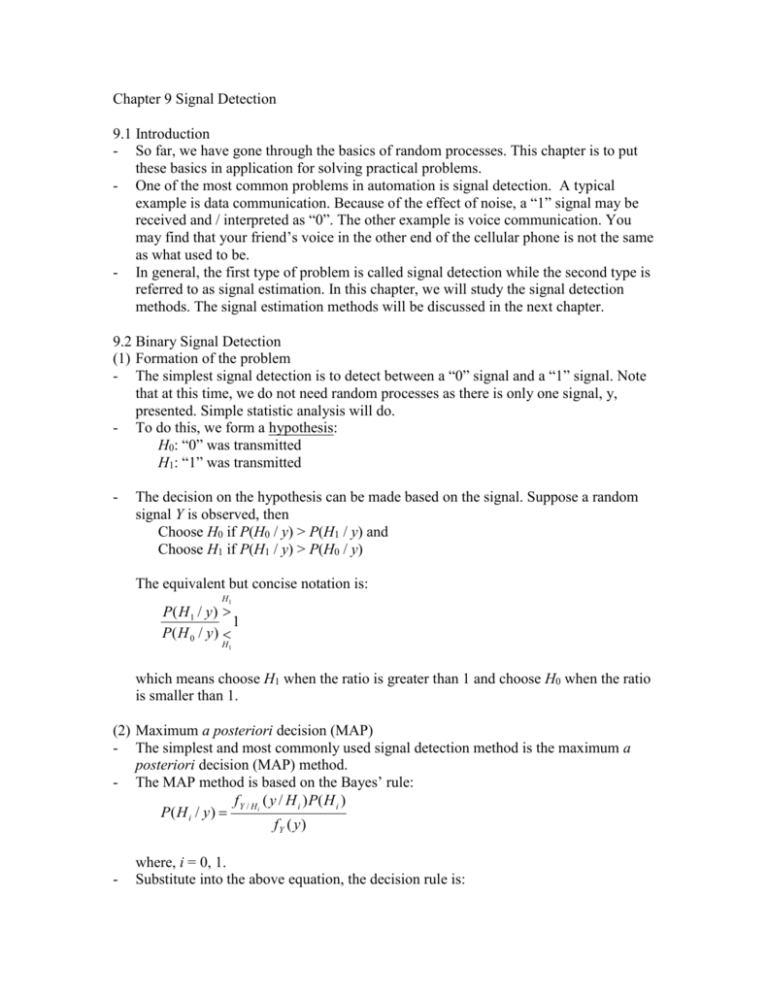
Chapter 9 Signal Detection
9.1 Introduction
- So far, we have gone through the basics of random processes. This chapter is to put
these basics in application for solving practical problems.
- One of the most common problems in automation is signal detection. A typical
example is data communication. Because of the effect of noise, a “1” signal may be
received and / interpreted as “0”. The other example is voice communication. You
may find that your friend’s voice in the other end of the cellular phone is not the same
as what used to be.
- In general, the first type of problem is called signal detection while the second type is
referred to as signal estimation. In this chapter, we will study the signal detection
methods. The signal estimation methods will be discussed in the next chapter.
9.2 Binary Signal Detection
(1) Formation of the problem
- The simplest signal detection is to detect between a “0” signal and a “1” signal. Note
that at this time, we do not need random processes as there is only one signal, y,
presented. Simple statistic analysis will do.
- To do this, we form a hypothesis:
H0: “0” was transmitted
H1: “1” was transmitted
-
The decision on the hypothesis can be made based on the signal. Suppose a random
signal Y is observed, then
Choose H0 if P(H0 / y) > P(H1 / y) and
Choose H1 if P(H1 / y) > P(H0 / y)
The equivalent but concise notation is:
H1
P( H 1 / y )
1
P( H 0 / y)
H1
which means choose H1 when the ratio is greater than 1 and choose H0 when the ratio
is smaller than 1.
(2) Maximum a posteriori decision (MAP)
- The simplest and most commonly used signal detection method is the maximum a
posteriori decision (MAP) method.
- The MAP method is based on the Bayes’ rule:
f Y / H i ( y / H i ) P( H i )
P( H i / y )
fY ( y)
-
where, i = 0, 1.
Substitute into the above equation, the decision rule is:
H1
f Y / H1 ( y / H 1 ) P ( H 1 )
1
f Y / H 0 ( y / H 0 ) P( H 0 )
H0
or:
H1
f Y / H1 ( y / H 1 ) P ( H 0 )
f Y / H 0 ( y / H 0 ) P( H 1 )
H0
-
-
-
Note that the ratio:
f Y / H1 ( y / H1 )
L( y )
fY / H0 ( y / H 0 )
is called the a likelihood ratio. The MAP decision rule consists of comparing this
ratio with the constant P(H0) / P(H1), which is called the decision threshold.
If we have multiple observations, Y1, Y2, …, Yn, the a likelihood ratio become:
f Y / H1 ( y1 , y 2 ,..., y n / H1 )
L( y1 , y 2 ,..., y n )
f Y / H 0 ( y1 , y 2 ,..., y n / H 0 )
When decision are based on noisy observations, there is always a chance that some of
the decisions may be incorrect. In the binary hypothesis testing problem, we have, as
shown below, four possibilities:
(a) Decide in favor of H0 when H0 is true (correct decision)
(b) Decide in favor of H1 when H1 is true (correct decision)
(c) Decide in favor of H1 when H0 is true (false decision, type-I error)
(d) Decide in favor of H0 when H1 is true (false decision, type-II error)
The probability of error is:
Pe = P(H0)P(D1 / H0) + P(H1)P(D0 / H1)
Type I error
Type II error
Moved threshold
will reduce Type
II error but
sacrifice Type I
error
H0
threshold
H1
-
-
An example: In a binary communication system, the received signal is:
Y=X+N
where, X = 0, 1 represents the signal and N ~ N(0, 1/9) is an independent white noise.
Given P(X = 0) = ¾ and P(X = 1) = ¼
(a) Derive the MAP decision rule
(b) Calculate the error probability
Solution:
- Form the hypothesis:
H0: “0” was transmitted
H1: “1” was transmitted
-
Calculate the a likelihood ratio:
9
9
f Y H 0 ( y / H 0 ) f Y / X ( y / 0)
exp y 2
2
2
9
9
f Y H1 ( y / H1 ) f Y / X ( y / 1)
exp ( y 1) 2
2
2
9
2
exp y 1
2
L( y )
9
exp y 2
2
-
Calculate the threshold. Since P(X = 0) = ¾ and P(X = 1) = ¼, the threshold is:
P(H0) / P(H1) = ¾ / ¼ = 3
-
Therefore, the decision rule is:
H1
9
exp 2 y 1 3
2
H0
or by taking logarithm:
H1
y
0.622
H0
-
Based on the threshold, we can calculate the error probability:
P(D0 / H1) = P[Z > (1 - 0.662)/(1/3)] = 0.128
P(D1 / H0) = P[Z > (0.662 - 0)/(1/3)] = 0.031
Hence:
Pe = (3/4)(0.128) + (1/4)(0.031) = 0.55
(3) Bayes’ decision
- The cost of making a false alarm and missing an alarm could be different. Let
C00 – the cost of detecting H0 when H0 is true
C01 – the cost of detecting H0 when H1 is true (miss alarm)
C10 – the cost of detecting H1 when H0 is true (false alarm)
C11 – the cost of detecting H1 when H1 is true
Note that C00 and C11 should be very small. The total cost of the decision is:
C Cij P( H j ) P( Di / H j )
i 0 ,1 j 0 ,1
-
The Bayes’ decision is the one that minimize the above cost and can be written as
follows:
H1
f Y / H1 ( y / H 1 ) P( H 0 )C10 C00
f Y / H 0 ( y / H 0 ) P( H 1 )C01 C11
H0
-
Note that when C00 = C11 = 0 and C01 = C10 = 1, Bayes’ decision is the same as the
Binary decision (there are books consider Binary decision as a Beyes’s decision).
In the above example, suppose that C00 = C11 = 0, C01 = 2 and C10 = 1, (miss alarm
causes twice as much damage as that of false alarm), then:
[(1)P(H0)] / [(2)P(H1)] = 3/2
Therefore, the decision rule is:
H1
9
3
exp 2 y 1
2
2
H0
(4) Decision with multiple (continuous) observations
- When continuous (multiple) observations are presented, we have to deal with random
processes:
Y(t) = X(t) + N(t), 0 t T
where,
s (t ) under hypothesis H 0
X (t ) 0
s1 (t ) under hypothesis H1
-
-
Note that s0(t) and s1(t) are deterministic but may be in many different forms. The
simplest one is s0(t) = -1 and s1(t) = 1, 0 t T (or s0(t) = 0 and s1(t) = 1, 0 t T).
Assuming that we take m samples in the time interval (0, T): Yk = Y(tk), k = 1, 2, …,
m, then the detection hypothesis is:
yk = s0,k + nk, under H0
yk = s1,k + nk, under H1
This problem can be solved by MAP method. Let Y = [Y1, Y2, …, Ym]T, and y = [y1,
y2, …, ym]T, then:
H1
f Y / H1 ( y / H 1 ) P ( H 0 )
L( y )
f Y / H 0 (y / H 0 ) P( H 1 )
H0
-
The forms of L(y) function depends on the problem distribution of the noise
disturbance. Let us consider two cases: N(t) is a white noise and N(t) is a “color
noise”.
(5) Signal detection under white noise
- We have learned that a white noise, N(t), has a Gaussian distribution with:
- E{N(t)} = 0
- E{N2(t)} = 2 = N0B
sin 2B
- RNN ( ) N 0 B
2B
N0
f B
- S NN ( f ) 2
0 elsewhere
-
Hence, the conditional distribution of Y is Gaussian with:
m
y s 2
1
f Y / H i y / H i
exp k 2i ,k
2
2
k 1
-
Through calculus, we can show that the detection rule is:
H1
P( H 0 ) 1 T
T
y s1 s 0 2 ln
s1 s1 s 0 s 0
P( H 1 ) 2
T
H0
where, si = [si,1, si,2, …, si,m]T, i = 0, 1.
-
-
An example: A binary communication system sends an equiprobable sequences of 1’s
and 2’s. However, we receive the signal together with a white noise that has the
power spectral density:
10 7
f 106
S NN ( f )
0 elsewhere
Furthermore, suppose the receiver samples 10 data points for each bit, what is the
detection rule and the average probability of error?
Solution:
- Since the sequence has equiprobable 1’s and 2’s, P(H0) / P(H1) = 1. The detection
rule becomes
H1
y T s1 s 0
1 T
s1 s1 sT0 s 0
2
H0
where, yi = [yi,1, yi,2, …, yi,m]T, s1 = [2, 2, …, 2]T, s0 = [1, 1, …, 1]T, Hence, the
detection rule is:
H1
m
y
i 1
i
3m
2
H0
or:
H1
1 m
yi 1.5
m i 1
H0
-
the probability of error can be found by comparing the threshold 1.5 to the
average value of the samples:
1 m
Z Yi
m i 1
Note that Z has a Gaussian distribution with zero mean and variance of
1 m
2
Z2 var Z var N (ti ) N
m i 1
m
where:
N2 S NN ( f )df 0.2
Hence, Z2 = 0.004
-
based on the definition:
Pe = P(H0)P(D1 / H0) + P(H1)P(D0 / H1)
= (½)P[Z > (1.5 - 1)/(0.063)] + (½)P[Z > (2 - 1.5)/(0.063)]
= 0.0002
(6) Signal detection under color noise
- The difference between white noise and “color noise” is the covariance. The later has
a covariance matrix:
[ ij ] E N (t i ) N (t j )
-
-
which has nonzero terms in the non-diagonal terms.
Considering the covariance and taking the logarithm, we have:
1
1
ln L(y ) y T N1s1 y T N1s 0 s T0 N1s 0 s1T N1s1
2
2
Therefore, the detection rule is:
H1
P( H 0 )
1
1
y T N1s1 y T N1s 0 sT0 N1s 0 s1T N1s1 ln
2
2
P( H 1 )
H0
